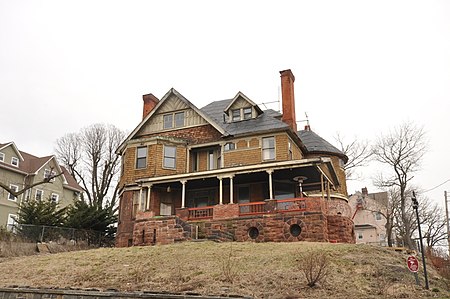Leffingwell–Batcheller House
Buildings and structures in Yonkers, New YorkHouses completed in 1889Houses on the National Register of Historic Places in New York (state)National Register of Historic Places in Yonkers, New YorkQueen Anne architecture in New York (state) ... and 1 more
Westchester County, New York Registered Historic Place stubs

Leffingwell–Batcheller House is a historic home located at Yonkers, Westchester County, New York. It was designed by noted New York architect R. H. Robertson and built between about 1887 and 1889. It is a 2+1⁄2-story, masonry and frame dwelling in the Queen Anne style. It has a hipped roof with gabled dormers and sheathed in rough-hewn brownstone, pressed and common brick, wood shingle, and wood clapboard. It features a broad verandah, a two-story rounded bay, and a rounded bay with conical roof.: 3–4 It was listed on the National Register of Historic Places in 2015.
Excerpt from the Wikipedia article Leffingwell–Batcheller House (License: CC BY-SA 3.0, Authors, Images).Leffingwell–Batcheller House
Flagg Street, City of Yonkers
Geographical coordinates (GPS) Address Nearby Places Show on map
Geographical coordinates (GPS)
| Latitude | Longitude |
|---|---|
| N 40.941944444444 ° | E -73.8925 ° |
Address
Flagg Street 44
10703 City of Yonkers
New York, United States
Open on Google Maps









